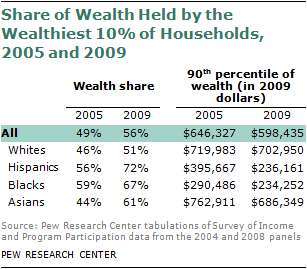
Just as the wealth gap between whites, Hispanics and blacks expanded in favor of whites during the time period under study, it also widened in favor of the wealthiest within each racial and ethnic group. The share of total wealth held by the top 10% of households in the wealth rankings increased from 2005 to 2009 within all groups.
This did not happen because the rich got richer. They did not: the inflation-adjusted threshold for entry into the wealthiest 10% decreased from 2005 to 2009 for all racial and ethnic groups. Even so, those in the top 10% of the wealth ladder were relatively less affected by the economic downturn than those in the remaining 90%, and this was the case for all groups. Also, as noted earlier, the share of households with zero or negative net worth increased among all groups.
Among all U.S. households, the share of wealth held by the top 10% increased from 49% in 2005 to 56% in 2009. The increase in the degree of concentration at the top was the greatest among Asians and Hispanics. The share of the top 10% went up from 44% to 61% among Asians and it rose from 56% to 72% among Hispanics. Among blacks, the share increased from 59% to 67%. The increase in wealth disparity was the lowest among whites, with the share of the top 10% increasing from 46% to 51%.
Although wealth grew more concentrated at the top, the threshold for entry into the top 10% was lower in 2009 than in 2005. For all U.S. households, the threshold, which is the 90th percentile of the wealth distribution, decreased 7%, from $646,327 to $598,435. The drop among Hispanics was more dramatic, from $395,667 to $236,161, or 40%. The threshold fell 19% among blacks and 10% among Asians, but only 2% among whites.




